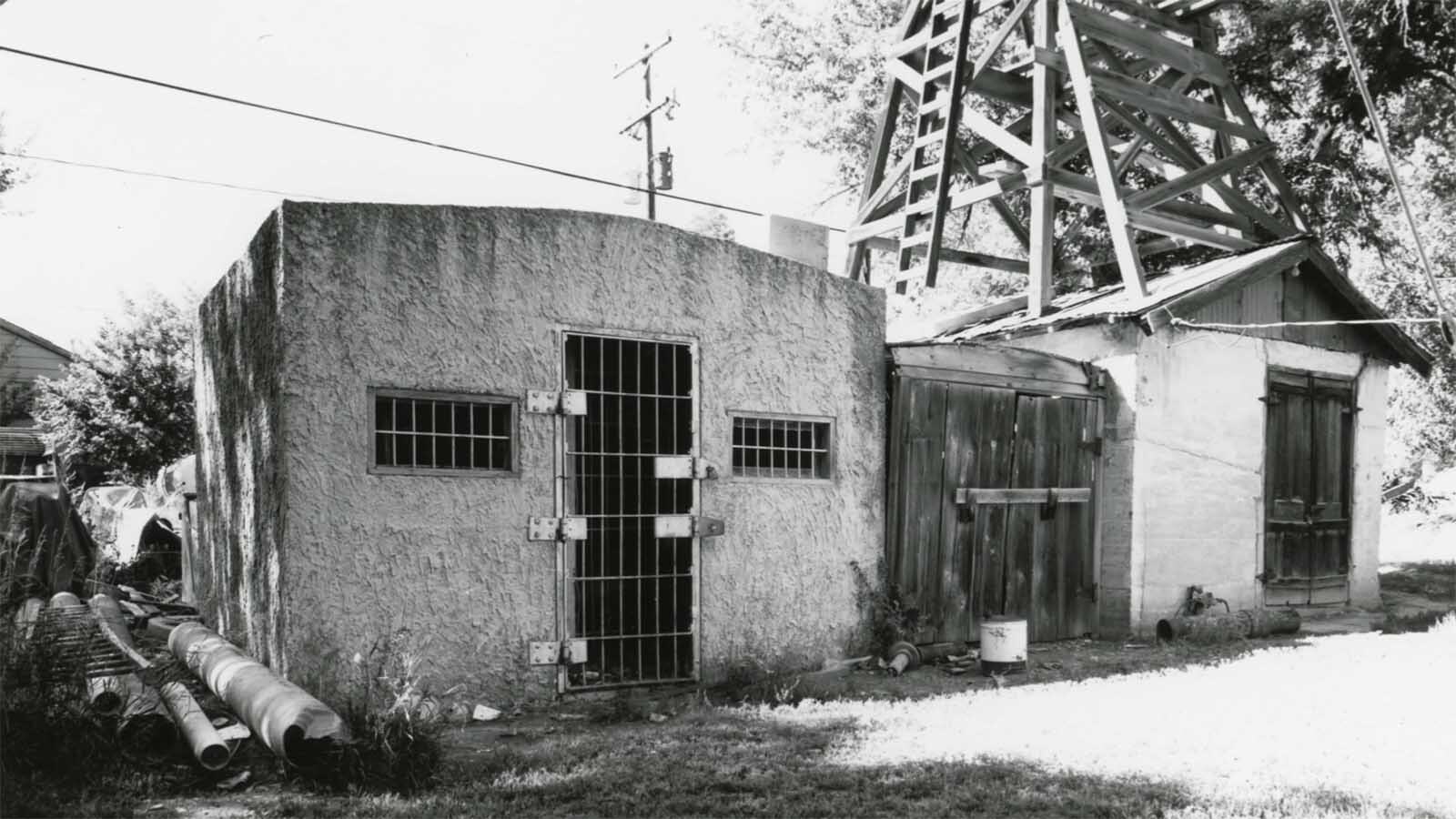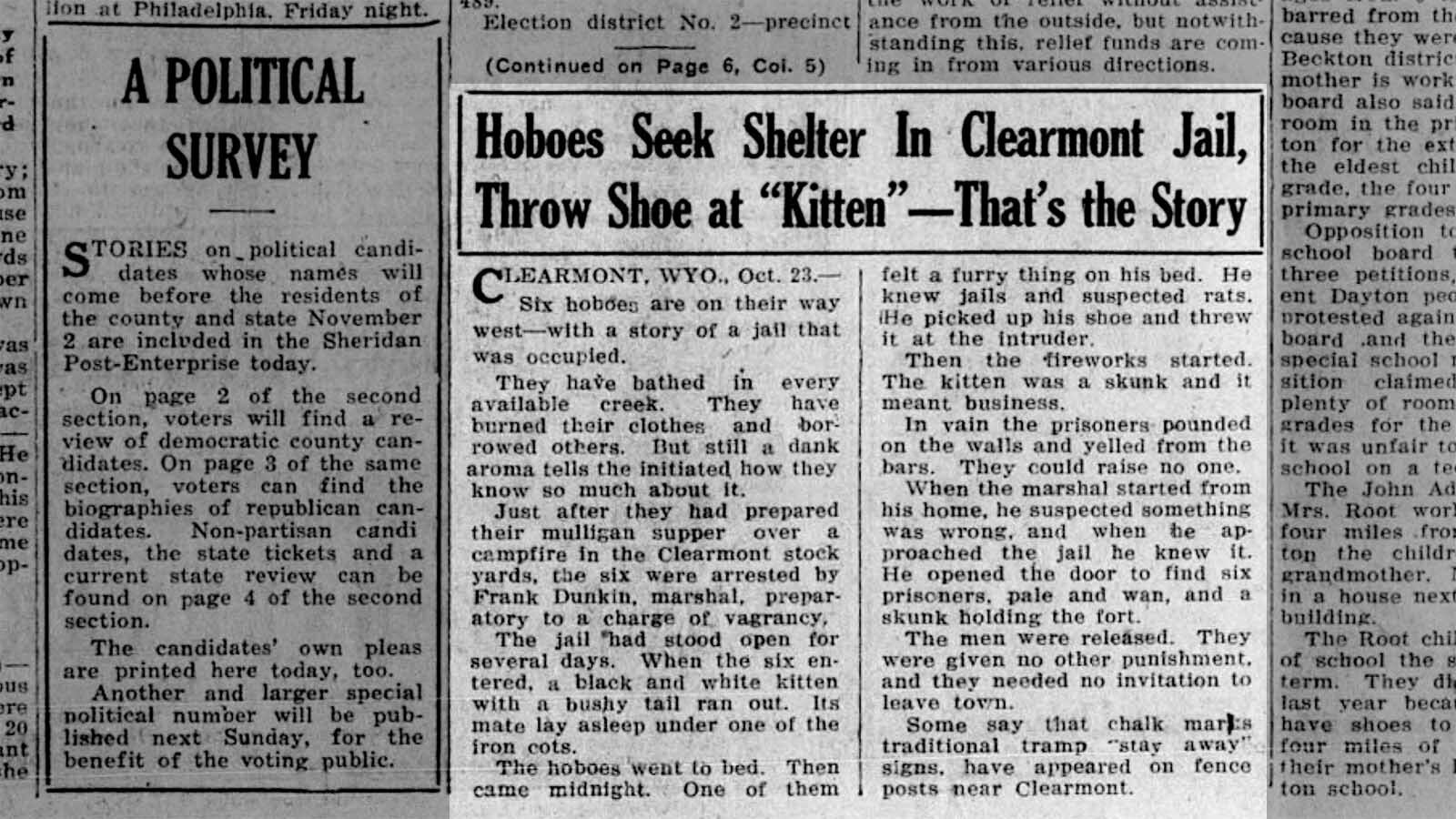Visitors to Branding Iron Park in tiny Clearmont, Wyoming, (population 125) will find a little building behind the water tower and beside a kid’s slide.
It’s the town’s historic and storied jail, built to hold drunks and booze runners during Prohibition in a town once described as “bloody Clearmont.”
It once housed “skunks” of the human nature and on at least one occasion a couple of the animal variety.
The tiny concrete-and-steel jail is still owned by the town, and is best known now for the prisoners that were even too much for the usual roundup of hobos to take in 1926.
A pair of skunks got into the cells, then got mad with their new roommates.

The Postmaster
An article in Laramie’s Daily Boomerang on Aug. 22, 1922, referred to John Toner of Kendrick, Wyoming, who served as postmaster there.
Toner was placed in the Clearmont Jail for violating prohibition and not being able to come up with a $1,000 bond.
“Two stills were found on the Toner ranch and 11 gallons of finished product,” the newspaper reported. “One of them had a daily capacity of only 10 gallons.”
A few years later, the Sheridan-Post Enterprise had a front-page story about then-town marshal Frank Dunkin arresting six hobos for vagrancy and herding them into the tiny jail after the door to the jail had “stood open for several days.”
“When the six entered in, a black-and-white kitten with a bushy tail ran out. Its mate lay asleep under one of the iron cots,” the newspaper reported Oct. 24, 1926. “The hoboes (sic) went to bed and then came midnight. One of them felt a furry thing on his bed. He knew jails and suspected rats. He picked up a shoe and threw it at the intruder.
“The kitten was a skunk, and it meant business,” the newspaper wrote.
The prisoners yelled and banged on bars, but no one responded.
When Dunkin arrived at the jail in the morning, he knew upon approaching the structure he had an issue. The newspaper reported that the prisoners were “pale and wan,” and the skunks were “holding the fort.”
The hoboes were released with no additional punishment.
“They needed no invitation to leave town,” the newspaper reported.
It’s Aired Out Fine
Nearly a century later, the skunk smell has long been aired out of the jail. But little else has changed about the little building.
It retains its small barred windows and two cells, and provides a link to the days when cowboys rode into town for a wild Saturday night and later railroad workers went on a drunken binge after payday.
Clearmont Historic Group President Robert Prusak, whose group has a small museum in the town that tries to preserve the history of Clearmont and Clear Creek Valley, said the jail was built in 1922.
“Clearmont had a marshal, and they needed a place to incarcerate people for whatever reason,” he said. “The original jail had two rooms, and it cost $827 to build. It’s just concrete and it’s got a couple of steel barred windows.”
Prusak said the 12-by-14-by-9-foot structure was added to the National Registry of Historic Places in the 1980s.
Twenty years or so before the town was established in 1919, the gathering of tar paper shacks where the Burlington railroad arrived in 1892 was known as “Bloody Clearmont,” the Sheridan Press reported in an Oct. 21, 1967, story. “Almost every week cowboys rode in and shot up the town,” the newspaper wrote.
At some point it its early beginnings, Clearmont boasted four saloons.

A ‘Deterrent’
Prusak said he believes the jail was essentially built as a “deterrent” to crime in the community. It initially did not have any heat and the toilet facilities consisted of prisoners being given a can to do their business in.
Information submitted with the historic registry nomination form for the jail in 1983 states that the structure had walls 5.5 inches thick, two cells, and two barred windows.
The jail was built at the request of the agricultural development firm Leiter Estates because of the number of migrant agricultural workers in the area and a growing crime rate.
Prusak said early on the town council decided to add a coal and wood stove to the structure. During many of its years of operation, prisoners were taken to a town cafe for meals and to wash up.
The little squat structure got some use.
Dunkin was reported to have a reputation for being good with his fists. He did not carry a gun, according to the information in the historic registry.
One day he dealt with a notorious local character named Pete Redman. Redman had made headlines in the Sheridan Enterprise in April 1922 for spending 27 days in the Sheridan County jail.
Dunkin’s encounter with Redman came later and showed off his boxing skills and established himself as the law in town.
“He was remembered as a ‘gutty little man’ who never carried a gun but could march a ‘whole line of gandy dancers to jail by himself,’” the registry nomination states.
Dunkin is said to have used the facility mainly for bootleggers and drunks.
In the 1950s the jail was presided over by town Marshal Bill Campbell. The national historic registry nomination form said he used the jail for “temporary railroad workers” who would get drunk and cause disturbances after payday.

Father’s Day Finale
The facility was officially employed for the final time on Father’s Day in June 1961 when two juveniles were arrested for public intoxication.
Town Marshal Albert Jennings released them in time for church on Sunday, according to the national registry nomination form for the jail.
Prusak said the jail building remains something of interest for people passing through town.
Clearmont sits on U.S. Highway 14-16 that once was referred to as the “Black and Yellow Trail” because it was the only way to go from the Black Hills to Yellowstone and back in the day, Prusak said.
A historic marker on the road in Clearmont now alerts people to the jail a block away.
Prusak said the historical group’s museum, which is open during summers on Wednesdays and Saturdays also directs people to check out the structure.
Access to get inside the jail is controlled through the town, Prusak said. There have been issues with vandalism in the past.
While the stove is gone, the chimney for it remains on the jail. Visitors will find it much the same as in 1922 when it opened for business.
“It’s cool, and it’s still in really good shape,” Prusak said. “And the doors still clank shut.”
Just check for skunks before stepping inside.
Contact Dale Killingbeck at dale@cowboystatedaily.com

Dale Killingbeck can be reached at dale@cowboystatedaily.com.





